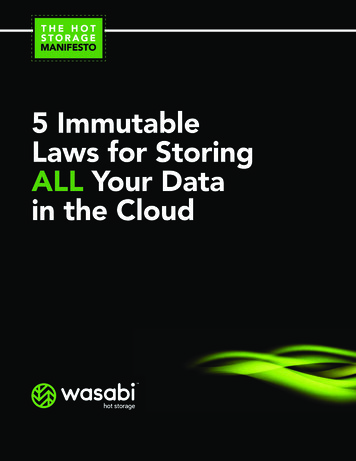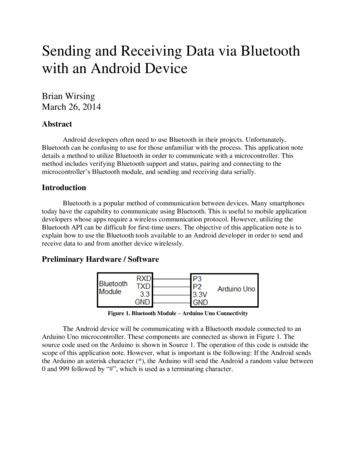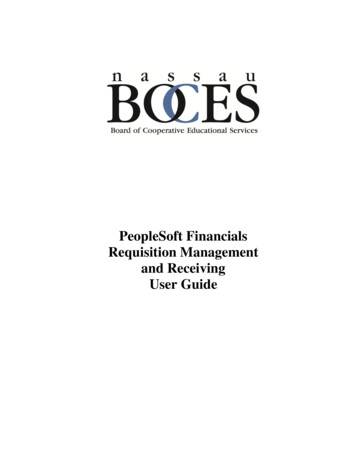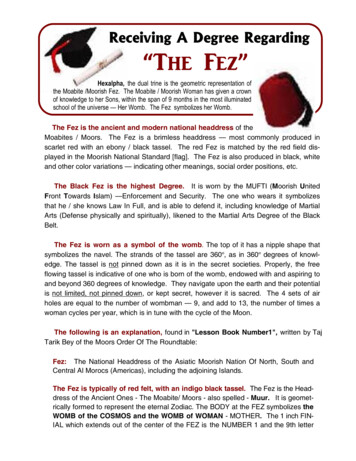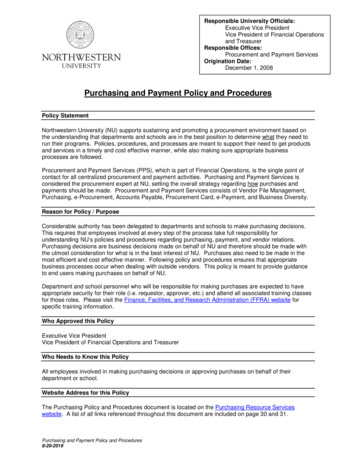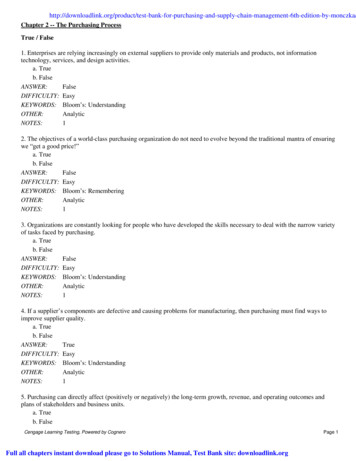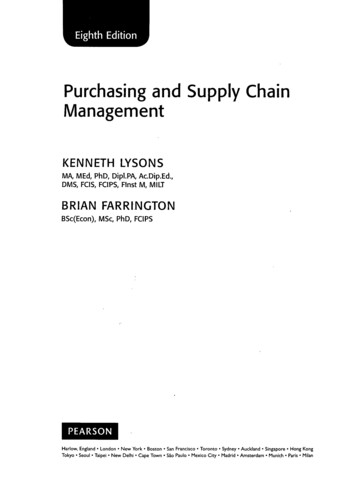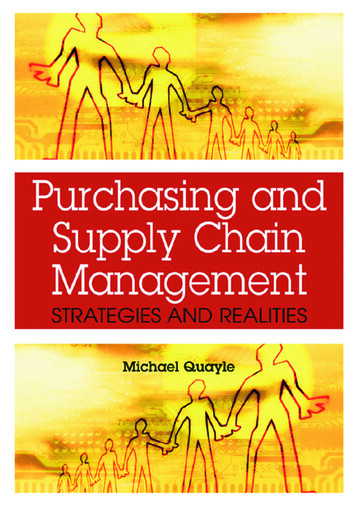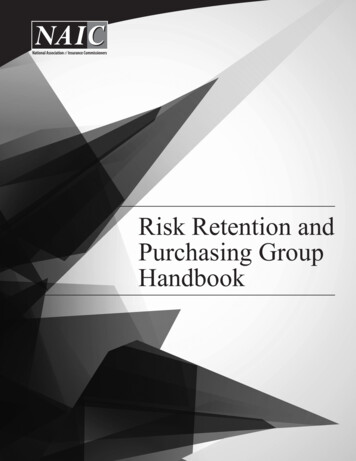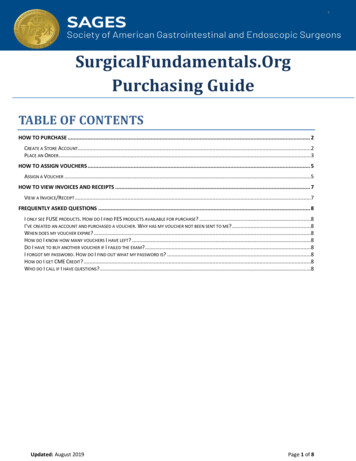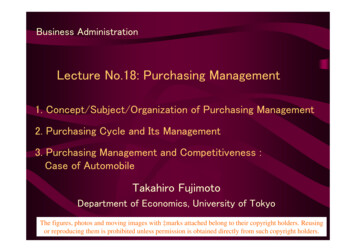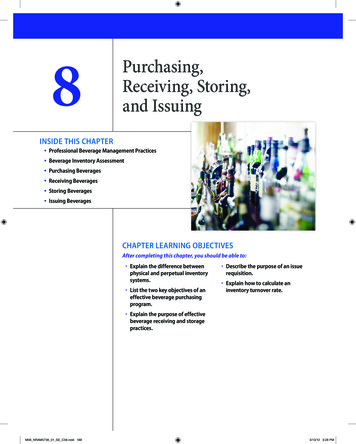
Transcription
8Purchasing,Receiving, Storing,and IssuingInside This Chapter Professional Beverage Management Practices Beverage Inventory Assessment Purchasing Beverages Receiving Beverages Storing Beverages Issuing BeveragesChapter Learning ObjectivesAfter completing this chapter, you should be able to: Explain the difference betweenphysical and perpetual inventorysystems. L ist the two key objectives of aneffective beverage purchasingprogram. D escribe the purpose of an issuerequisition. Explain how to calculate aninventory turnover rate. Explain the purpose of effectivebeverage receiving and storagepractices.M08 NRAM5738 01 SE C08.indd 1883/13/12 3:28 PM
Key Termsaverage inventory,p. 207first in, first out (FIFO),p. 193license state, p. 194capital, p. 197inventory turnover rate,p. 207perpetual inventory,p. 192last in, first out (LIFO),p. 193physical inventory, p. 191cash flow, p. 197control state, p. 194cost of goods sold (COGS),p. 207lead time, p. 198order point, p. 198rotation, p. 201safety level, p. 198Case Study“How can you run out of my favorite gin?”, demanded the customer.Marco, the bartender at the Votive Restaurant, tried to explain. “We reallydon’t sell much of that brand. It looks like we forgot to restock it and we ranout. I can get you another brand.”Marco knew this guest, who was usually friendly and tipped well. But nottoday.“Young man,” grumbled the customer, getting up to leave, “if I wanted badgin, I would have gone somewhere else. I came here because you usually havethe best bar selection in town.”“This happens way too often,” thought Marco. “Last week we ran out of apremium vodka. And the week before that, we ran out of our most populardraft beer.”Both times some customers got mad, and it showed up in lower tips. Marcowondered why the manager couldn’t keep the right products in the rightamounts on hand at the right time.1. How do you think the lack of popular beverages affects the customersand the employees of an establishment?2. What will happen in an establishment if it continually runs out of thebeverage brands or products its customers prefer?189M08 NRAM5738 01 SE C08.indd 1893/13/12 3:28 PM
CHAPTER 8Purchasing, Receiving, Storing, and IssuingPROFESSIONAL BEVERAGE MANAGEMENT PRACTICESManagers face a variety of challenges in securing and maintaining theproducts needed to serve drinks. They must consider which beverageproducts to buy. They must also consider the amount of beverage productsneeded to meet customer demand. After placing orders, managers mustensure that beverage products are properly received. The receiving processentails matching the products ordered with those delivered. It also meansensuring that the products have arrived in good condition. After the productis delivered, managers must safely store products, issuing them from storageas needed.The entire process of managing beverage products in storage involves severalseparate tasks: Inventory assessment Purchasing Receiving Storing IssuingBeverage Inventory AssessmentManagers seeking to understand beverage purchasing, receiving, storing,and issuing must begin by first understanding beverage inventoryprocedures. Most operations will have several inventories. These inventoriesinclude alcoholic beverages, glassware and dishes, food items, nonalcoholicbeverages, and cleaning and office supplies. An operation’s inventoryaccounts for both the amount and the value of the products held in theoperation. These inventory levels are also known in the industry as theamount “on hand.”The quantity of products on hand impacts decisions about when and howmuch more to purchase. Beverage managers should assess their inventorylevels on a regular basis. The frequency of inventory assessment will varybased on the size of an operation. It will also depend on the operation’svolume level. All beverage operations will benefit from a regular assessmentof inventory, because the inventory process allows managers to make severalkey decisions related to the following: Maintaining product quality Determining what to buy Determining how much to buy190M08 NRAM5738 01 SE C08.indd 1903/13/12 3:28 PM
Beverage Inventory Assessment Determining when to buy Determining costs Reducing theftRestaurant and foodservice professionals often use two basic systems as theymanage the products held in inventory: physical inventory and perpetualinventory.Physical InventoryManagers typically assess the amount of products they have on hand bytaking a physical inventory. In a physical inventory system, managers countand record the amounts of each product in storage. Typically, they alsodetermine the value of the products held in inventory. In some operations,managers require that two people, working together, take the physicalinventory. They do this to help ensure accuracy and to reduce controlproblems, such as theft.Exhibit 8.1 shows a physical inventory form that identifies the informationtypically collected for each inventoried item.Note that seven bottles of Old Hoshler whiskey were in the beveragestoreroom when the manager took the inventory count. Each bottle has apurchase price of 17.50. This was known because the cost per bottle wasrecorded when the product was delivered. Therefore, the total inventory costof this product is 122.50:7 17.50 122.50Total bottles Cost per bottle Cost priceExhibit 8.1Physical Inventory FormItemPurchase UnitNo. of Units Purchase Pricein InventoryTotal CostOld Hoshler WhiskeyBottle (750 ml)7 17.50 122.50Joliet GinBottle (1 L)422.7591.00Total 213.50191M08 NRAM5738 01 SE C08.indd 1913/13/12 3:28 PM
CHAPTER 8Purchasing, Receiving, Storing, and IssuingExhibit 8.2When managers complete a physical beverage inventory, theyknow the amounts and value of all products on hand. Thisinformation will be needed prior to determining what, if any, newproducts must be ordered.Some nonbeverage items used in a bar may be inventoriedregularly to determine when they must be reordered. Examplesinclude fruit, juices, and dairy products (Exhibit 8.2). A physicalbeverage inventory should be taken as often as is needed to assistmanagers in their purchasing tasks. It is normally taken at leastonce per month to determine the dollar value of beverageproducts on hand. This inventory is typically taken on the last dayof the month or accounting period and information from it is used to preparethe cost of beverages sold portion of the operation’s profit and loss statement(see chapter 9).Perpetual Inventory SystemA perpetual inventory system is a continuous count of the number of items ininventory. The amounts of product in a perpetual inventory system are notcontinually determined by a physical count, but by keeping a running total ofpurchases, or deposits, and usage, or withdrawals. Actual physical inventorycounts are, however, taken periodically to ensure the accuracy of theperpetual inventory system. The key advantage of a perpetual inventorysystem is that the managers always know the quantity of products that shouldbe available.Managers use a perpetual inventory system just like a checkbook. With acheckbook, as money is deposited in the bank, the balance on the accountgoes up. Likewise, as products are delivered to the storeroom, the perpetualinventory record increases. Conversely, asExhibit 8.3money is withdrawn from the bank, thePerpetual Inventory Formbalance in the bank decreases. The same isItem: Old Hatter Scotch (750 ml)true for the inventory. As products are issuedDateNo. of Purchase UnitsBalancefor use, the quantity of product in storageInOutdecreases. When their record keeping is good,7managers know the quantity of beverageproducts that should be in inventory all the9/15—52time.9/1612410Exhibit 8.3 shows the typical format for aperpetual inventory form.Notice that there were 7 bottles of Old Hatter Scotch available at thebeginning of the inventory period. On the first date of 9/15, 5 bottles wereissued, so only 2 bottles should have remained in inventory.192M08 NRAM5738 01 SE C08.indd 1923/13/12 3:28 PM
On the next day, 12 bottles were purchased and 4 bottles were issued. Therewas then a net balance of 10 bottles.2 12 4 10Bottles issuedBottles purchasedBottlesBottles beginningon 9/16on 9/16remaininginventoryWhen using a perpetual inventory system, the manager should spot-check thenumber of bottles in the storage area periodically. This ensures that thenumber of bottles on hand actually equals the balance indicated on theperpetual inventory form.Note that it is necessary to keep track of the quantity only, not the cost, ofproducts available in a perpetual inventory system. That is because aperpetual inventory system cannot be relied on to provide actual inventoryand cost data used to prepare an operation’s financial summaries. Eliminatingthe need to collect unnecessary information helps reduce the time requiredfor the perpetual inventory process. This makes the procedure more attractiveto busy beverage managers.FOR BUSESSIN7 5 2Bottles beginning inventory Bottles issued on 9/15 Bottles remainingOPENBeverage Inventory AssessmentRESTAURANTTECHNOLOGYComputerized systemsare available to help with inventory counts and to help establishinventory values. For example,optical scanners can be used toread bar codes on bottles ofproducts held in storage. Managers simply use the scanner to“count” each bottle and theprogram uses current prices paidfor products to calculate totalinventory values.Technology-driven approachesprovide fast and accurate methodsto determine inventory values. Asa result, technology is increasinglyused to replace the manualinventory systems currentlydeployed in many establishments.Use of a perpetual inventory system allows the beverage manager to bettercontrol beverage products. When verified with a regularly scheduled physicalcount, the beverage manager knows whether there is a discrepancy betweenrecorded information and physical count. As a result, he or she is able to takecorrective action on a timely basis.Calculating Inventory ValuesManagers should also know the value of the products they have in inventory.Recall from Exhibit 8.1 that a physical inventory form includes a space forrecording the value of products in inventory. Establishing the value of aninventory is more complex than it first appears. That is so because there arefour basic ways that values of beverage inventories can be assigned: FIFO: The first in, first out (FIFO) method assumes that products arewithdrawn from inventory in the order in which they are received andentered into storage. Therefore, the products that remain in storage arejudged to be the most recently purchased items. The value of inventorybecomes the cost of the most recently purchased products. LIFO: The last in, first out (LIFO) method assumes the reverse of theFIFO method: The products most recently purchased are used first. Thevalue of inventory is represented by the unit cost of items in inventorythe longest.193M08 NRAM5738 01 SE C08.indd 1933/13/12 3:28 PM
CHAPTER 8Purchasing, Receiving, Storing, and Issuing Actual cost: This method of inventory valuation considers the actualprice paid for each product in inventory. The inventory value is the sumof the actual unit costs. Weighted average: This method of inventory valuation considers thequantity of each product purchased at different unit prices. Theinventory value is priced on the basis of average prices paid for eachproduct, and the average price is weighted according to the number ofproducts purchased at each price.Managers choose one valuation system when taking a physical inventory andshould use that same system consistently. This is because there are taximplications and restrictions on changing inventory valuation methods.Normally, the beverage manager, working with another responsible employee,will determine the quantities and values of inventoried items. In smalloperations the manager-owner, working alone, may conduct inventory countsand assess product values.Purchasing BeveragesPurchasing involves the series of activities that begin when beverage andsupply needs are determined and ends after these items are sold or used bythe operation. This definition is broader than the common idea thatpurchasing simply means buying. Professional beverage purchasers mustdetermine what they need to buy, how much to buy, and when to buy it.Buying alcoholic beverages is very different from buying food products.Unlike with food products, government regulations often affect sources ofalcoholic beverage supply. States can be either control states or license states.In control, or monopoly, states the state is the sole supplier of liquor. Allindividuals and retail establishments must purchase liquor directly from statestores. In license states, the state frequently licenses wholesalers, distributors,and sometimes manufacturers to sell alcoholic beverages.Liquor purchasing is considerably more complex in license states than incontrol states. Wholesalers do not carry all brands in all quantities.Distributors usually have exclusive sales authority over certain brands. Somemanufacturers have their own distribution networks.These distribution networks can differ greatly. One beverage manufacturermay have its own distribution system, while another may give exclusiveterritorial rights to certain distributors. Still other manufacturers sell onlyto wholesalers. The end result of these different distribution networks isthat no single supplier carries a complete selection of all available brandsand items. For this reason, purchasers must order from several supplysources.194M08 NRAM5738 01 SE C08.indd 1943/13/12 3:28 PM
Purchasing BeveragesThe pricing of beverage products sold to restaurant and foodserviceoperations is also different from food products. Because of the strict controlimposed by government alcoholic beverage agencies, there is often very littleflexibility in their purchase price. Strict minimum wholesale pricerequirements severely
perpetual inventory system A perpetual inventory system is a continuous count of the number of items in inventory. The amounts of product in a perpetual inventory system are not continually determined by a physical count, but by keeping a running total of purchases, or deposits, and usage, or withdrawals. Actual physical inventory
